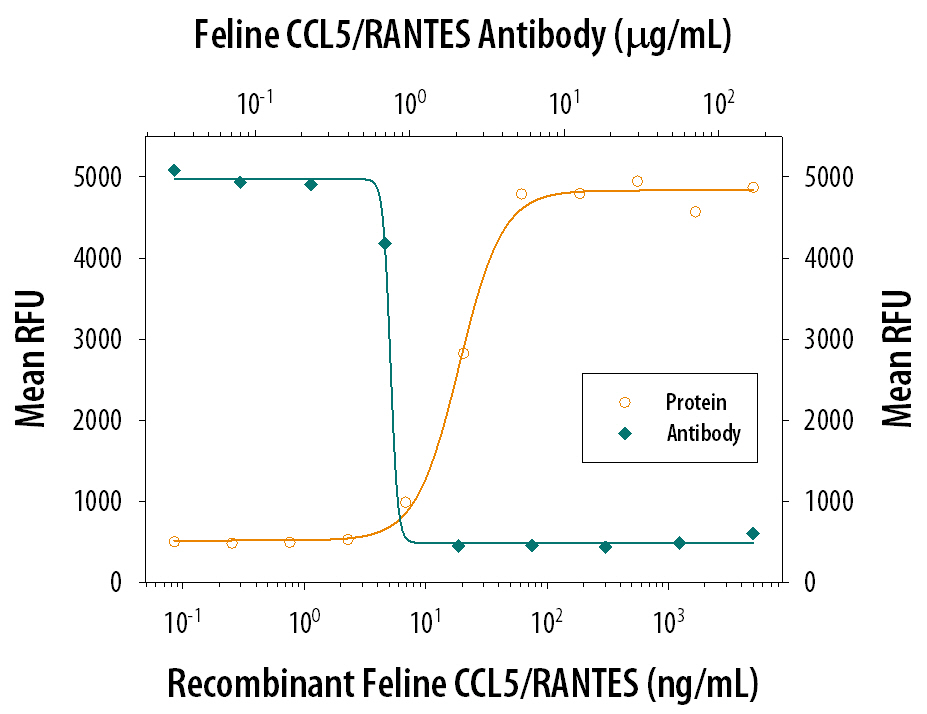Feline CCL5/RANTES Antibody Summary
Tyr26-Asn92 (Lys84Tyr and Gly85 del)
Accession # Q8SQ40
Applications
Feline CCL5/RANTES Sandwich Immunoassay
Please Note: Optimal dilutions should be determined by each laboratory for each application. General Protocols are available in the Technical Information section on our website.
Scientific Data
 View Larger
View Larger
Chemotaxis Induced by CCL5/RANTES and Neutral-ization by Feline CCL5/ RANTES Antibody. Recombinant Feline CCL5/ RANTES (Catalog # 3819-FR) chemoattracts the BaF3 mouse pro-B cell line transfected with human CCR5 in a dose-dependent manner (orange line). The amount of cells that migrated through to the lower chemotaxis chamber was measured by Resazurin (Catalog # AR002). Chemotaxis elicited by Recombinant Feline CCL5/ RANTES (80 ng/mL) is neutral-ized (green line) by increasing concen-trations of Sheep Anti-Feline CCL5/RANTES Antigen Affinity-purified Polyclonal Antibody (Catalog # AF3819). The ND50 is typically 0.5-2.5 µg/mL.
Reconstitution Calculator
Preparation and Storage
- 12 months from date of receipt, -20 to -70 °C as supplied.
- 1 month, 2 to 8 °C under sterile conditions after reconstitution.
- 6 months, -20 to -70 °C under sterile conditions after reconstitution.
Background: CCL5/RANTES
CCL5, also known as RANTES (Regulated upon Activation, Normal T cell Expressed and presumably Secreted), is an 8 kDa beta -chemokine that plays a primary role in the inflammatory immune response by means of its ability to attract and activate leukocytes (1‑3). Human and mouse RANTES exhibit cross-species activity on human and mouse cells (4). Mature feline CCL5 shares 84% aa seqeuence identity with canine CCL5 and 71%‑75% with cotton rat, human, mouse, and rat CCL5 (5). CCL5 is secreted by many cell types at inflammatory sites, and it exerts a wide range of activities through the receptors CCR1, CCR3, CCR4, and CCR5 (6, 7). Inflammatory responses can be impaired by the sequestration of CCL5 by the cytomegalovirus protein US28 (8). In humans, CCR5 binding to CCL5 inhibits the infectivity of R5 (M-tropic) but not X4 (T-tropic) strains of HIV-1 (9). The two N-terminal residues of CCL5 can be removed by CD26/DPPIV, generating a protein that functions as a chemotaxis inhibitor and more effectively blocks M-tropic HIV-1 infection of monocytes (10). Oligomerization of CCL5 on glycosaminoglycans is required for CCR1-mediated leukocyte adhesion and activation as well as CCL5’s interaction with the chemokine CXCL4/PF4 (11‑13). The deposition of CCL5 on activated vascular endothelial cells is crucial for monocyte adhesion to damaged vasculature, but CCL5 oligomerization is not required for the extravasation of adherent leukocytes (14‑16). CCL5 is upregulated in breast cancer and promotes tumor progression through the attraction of proinflammatory macrophages in addition to its actions on tumor cells, stromal cells, and the vasculature (17).
- Schall, T.J. et al. (1990) Nature 347:669.
- Bacon, K.B. et al. (1995) Science 269:1727.
- Fischer, F.R. et al. (2001) J. Immunol. 167:1637.
- Schall, T.J. et al. (1992) Eur. J. Immunol. 22:1477.
- Kimura, T. et al. (2003) Vet. Dermatol. 14:269.
- Appay, V. and S.L. Rowland-Jones (2001) Trends Immunol. 22:83.
- Levy, J.A. (2009) J. Immunol. 182:3945.
- Randolph-Habecker, J.R. et al. (2002) Cytokine 19:37.
- DeVico, A.L. and Gallo, R.C. (2004) Nat. Rev. Microbiol. 2:401.
- Proost, P. et al. (1998) J. Biol. Chem. 273:7222.
- Appay, V. et al. (1999) J. Biol. Chem. 274:27505.
- Proudfoot, A.E.I. et al. (2003) Proc. Natl. Acad. Sci. 100:1885.
- von Hundelshausen, P. et al. (2005) Blood 105:924.
- von Hundelshausen, P. et al. (2001) Circulation 103:1772.
- Zernecke, A. et al. (2008) Arterioscler. Thromb. Vasc. Biol. 28:1897.
- Baltus, T. et al. (2003) Blood 102:1985.
- Soria, G. and A. Ben-Baruch (2008) Cancer Lett. 267:271.
Product Datasheets
FAQs
No product specific FAQs exist for this product, however you may
View all Antibody FAQsReviews for Feline CCL5/RANTES Antibody
There are currently no reviews for this product. Be the first to review Feline CCL5/RANTES Antibody and earn rewards!
Have you used Feline CCL5/RANTES Antibody?
Submit a review and receive an Amazon gift card.
$25/€18/£15/$25CAN/¥75 Yuan/¥2500 Yen for a review with an image
$10/€7/£6/$10 CAD/¥70 Yuan/¥1110 Yen for a review without an image


